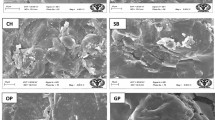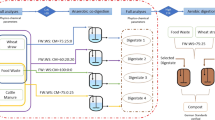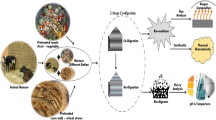Abstract
The purpose of this research is to experimentally evaluate the anaerobic co-digestion in the city of Guaranda of slaughterhouse residues (RM) with straw residues from agriculture, such as amaranth residues (AM), quinoa residues (QU) and residues of wheat (TR), to reduce slaughterhouse discharges and prevent contamination of the city. The study was carried out on a laboratory scale in 311-ml biodigesters under mesophilic conditions of 37 °C. In addition, sewage sludge was used as inoculum with two relationships between substrate and inoculum (SIR 1:1 and SIR 1:2). The design was completed using three relationships between substrate (RM) and co-substrate (AM, QU and TR): 25:75, 50:50 and 75:25. Anaerobic co-digestion resulted in methane yields of 407 ml CH4/g VS, with a methane content in the biogas of 77% for the mixture of RM and QU (RM-QU (25:75)). The increase in inoculum in the mixtures composed of RM and QU increased the biodegradability between 17 and 22%. However, in the mixtures of slaughterhouse waste and amaranth (RM-AM (25:75)), a further increase in inoculum reduced biodegradability by 5%. The results revealed that there is a greater synergy between the RM and QU as the percentage of QU in the mixture is increased. This meant that the co-digestion of the RM with the QU accelerates the biodegradability of the mixture, increasing the production of biogas.



Similar content being viewed by others
References
Luste S, Luostarinen S (2010) Anaerobic co-digestion of meat-processing by-products and sewage sludge—effect of hygienization and organic loading rate. Bioresour Technol 101:2657–2664. https://doi.org/10.1016/j.biortech.2009.10.071
Li R, Chen S, Li X et al (2009) Anaerobic codigestion of kitchen waste with cattle manure for biogas production. Energy Fuels 23:2225–2228. https://doi.org/10.1021/ef8008772
Jędrzejewska M, Kozak K, Krzemieniewski M (2006) Effect of reduced pressure on anaerobic blood biodegradation. Pol J Environ Stud 15:87–93
Nazifa TH, Saady NMC, Bazan C et al (2021) Anaerobic digestion of blood from slaughtered livestock: a review. Energies 14:5666. https://doi.org/10.3390/en14185666
Tritt WP, Schuchardt F (1992) Materials flow and possibilities of treating liquid and solid wastes from slaughterhouses in Germany. A review Bioresour Technol 41:235–245. https://doi.org/10.1016/0960-8524(92)90008-L
(2018) 2540 SOLIDS. In: Standard methods for the examination of water and wastewater. American Public Health Association
Meneses-Quelal WO, Velázquez-Martí B, Gaibor-Chávez J, Niño-Ruiz Z (2021) Biochemical potential of methane (BMP) of camelid waste and the Andean region agricultural crops. Renew Energy 168:406–415. https://doi.org/10.1016/j.renene.2020.12.071
Meneses Quelal WO, Velázquez-Martí B, Gaibor Chávez J et al (2021) Evaluation of methane production from the anaerobic co-digestion of manure of guinea pig with lignocellulosic Andean residues. Environ Sci Pollut Res. https://doi.org/10.1007/s11356-021-15610-x
Meneses-Quelal O, Velázquez-Martí B, Gaibor-Chávez J, Niño-Ruiz Z (2021) Effect of the co-digestion of agricultural lignocellulosic residues with manure from South American camelids. Biofuels, Bioprod Biorefining 15:525–544. https://doi.org/10.1002/bbb.2177
Angelidaki I, Alves M, Bolzonella D et al (2009) Defining the biomethane potential (BMP) of solid organic wastes and energy crops: a proposed protocol for batch assays. Water Sci Technol 59:927–934. https://doi.org/10.2166/wst.2009.040
Franqueto R, da Silva JD, Konig M (2020) Effect of temperature variation on codigestion of animal waste and agricultural residue for biogas production. BioEnergy Res 13:630–642. https://doi.org/10.1007/s12155-019-10049-y
Herrmann A, Rath J (2012) Biogas production from maize: current state, challenges, and prospects. 1. Methane Yield Potential. BioEnergy Res 5:1027–1042. https://doi.org/10.1007/s12155-012-9202-6
Zahan Z, Othman MZ, Muster TH (2018) Anaerobic digestion/co-digestion kinetic potentials of different agro-industrial wastes: a comparative batch study for C/N optimisation. Waste Manag 71:663–674. https://doi.org/10.1016/j.wasman.2017.08.014
Velázquez-Martí B, Meneses O, Gaibor J, Niño Z (2018) Review of mathematical models for the anaerobic digestion process. In Anaerobic digestion. Intech Open, J. Rajesh Banu. https://doi.org/10.5772/intechopen.80815
Pitt RE, Cross TL, Pell AN et al (1999) Use of in vitro gas production models in ruminal kinetics. Math Biosci 159:145–163. https://doi.org/10.1016/S0025-5564(99)00020-6
Alvarez R, Lidén G (2008) Anaerobic co-digestion of aquatic flora and quinoa with manures from Bolivian Altiplano. Waste Manag 28:1933–1940. https://doi.org/10.1016/j.wasman.2007.11.002
Sun J, Li Z, Zhou X et al (2019) Investigation on methane yield of wheat husk anaerobic digestion and its enhancement effect by liquid digestate pretreatment. Anaerobe 59:92–99. https://doi.org/10.1016/j.anaerobe.2019.05.009
Seppälä M, Laine A, Rintala J (2013) Screening of novel plants for biogas production in northern conditions. Bioresour Technol 139:355–362. https://doi.org/10.1016/j.biortech.2013.04.014
Pabón Pereira CP (2009) Anaerobic digestion in sustainable biomass chains. PhD theses. Wageningen University
Pellera F-M, Gidarakos E (2016) Effect of substrate to inoculum ratio and inoculum type on the biochemical methane potential of solid agroindustrial waste. J Environ Chem Eng 4:3217–3229. https://doi.org/10.1016/j.jece.2016.05.026
Fernández J, Pérez M, Romero LI (2008) Effect of substrate concentration on dry mesophilic anaerobic digestion of organic fraction of municipal solid waste (OFMSW). Bioresour Technol 99:6075–6080. https://doi.org/10.1016/j.biortech.2007.12.048
Cuetos MJ, Gómez X, Otero M, Morán A (2008) Anaerobic digestion of solid slaughterhouse waste (SHW) at laboratory scale: Influence of co-digestion with the organic fraction of municipal solid waste (OFMSW). Biochem Eng J 40:99–106. https://doi.org/10.1016/j.bej.2007.11.019
Alvarez R, Lidén G (2008) Semi-continuous co-digestion of solid slaughterhouse waste, manure, and fruit and vegetable waste. Renew Energy 33:726–734. https://doi.org/10.1016/j.renene.2007.05.001
Rosenwinkel K-H, Meyer H (1999) Anaerobic treatment of slaughterhouse residues in municipal digesters. Water Sci Technol 40:101–111. https://doi.org/10.1016/S0273-1223(99)00369-8
Borowski S (2015) Co-digestion of the hydromechanically separated organic fraction of municipal solid waste with sewage sludge. J Environ Manage 147:87–94. https://doi.org/10.1016/j.jenvman.2014.09.013
Bouallagui H, Ben Cheikh R, Marouani L, Hamdi M (2003) Mesophilic biogas production from fruit and vegetable waste in a tubular digester. Bioresour Technol 86:85–89. https://doi.org/10.1016/S0960-8524(02)00097-4
Scano EA, Asquer C, Pistis A et al (2014) Biogas from anaerobic digestion of fruit and vegetable wastes: experimental results on pilot-scale and preliminary performance evaluation of a full-scale power plant. Energy Convers Manag 77:22–30. https://doi.org/10.1016/j.enconman.2013.09.004
Lin J, Zuo J, Gan L et al (2011) Effects of mixture ratio on anaerobic co-digestion with fruit and vegetable waste and food waste of China. J Environ Sci 23:1403–1408. https://doi.org/10.1016/s1001-0742(10)60572-4
BIRCH CPD (1999) A new generalized logistic sigmoid growth equation compared with the Richards growth equation. Ann Bot 83:713–723. https://doi.org/10.1006/anbo.1999.0877
Ware A, Power N (2017) Modelling methane production kinetics of complex poultry slaughterhouse wastes using sigmoidal growth functions. Renew Energy 104:50–59. https://doi.org/10.1016/j.renene.2016.11.045
Patil JH, Raj MA, Muralidhara PL et al (2012) Kinetics of anaerobic digestion of water hyacinth using poultry litter as inoculum. Int J Environ Sci Dev 3:94. https://doi.org/10.7763/IJESD.2012.V3.195
Raposo F, Borja R, Martín MA et al (2009) Influence of inoculum–substrate ratio on the anaerobic digestion of sunflower oil cake in batch mode: process stability and kinetic evaluation. Chem Eng J 149:70–77. https://doi.org/10.1016/j.cej.2008.10.001
Kafle GK, Kim SH, Sung KI (2013) Ensiling of fish industry waste for biogas production: a lab scale evaluation of biochemical methane potential (BMP) and kinetics. Bioresour Technol 127:326–336. https://doi.org/10.1016/j.biortech.2012.09.032
Song H, Clarke WP (2009) Cellulose hydrolysis by a methanogenic culture enriched from landfill waste in a semi-continuous reactor. Bioresour Technol 100:1268–1273. https://doi.org/10.1016/j.biortech.2008.08.029
Hu Z-H, Yu H-Q (2005) Application of rumen microorganisms for enhanced anaerobic fermentation of corn stover. Process Biochem 40:2371–2377. https://doi.org/10.1016/j.procbio.2004.09.021
Fernández-Rodríguez MJ, de la Lama-Calvente D, Jiménez-Rodríguez A et al (2019) Anaerobic co-digestion of olive mill solid waste and microalga Scenedesmus quadricauda: effect of different carbon to nitrogen ratios on process performance and kinetics. J Appl Phycol 31:3583–3591. https://doi.org/10.1007/s10811-019-01858-x
Solé-Bundó M, Salvadó H, Passos F et al (2018) Strategies to optimize microalgae conversion to biogas: co-digestion, pretreatment and hydraulic retention time. Molecules 23:2096. https://doi.org/10.3390/molecules23092096
Zhang R, El-Mashad HM, Hartman K et al (2007) Characterization of food waste as feedstock for anaerobic digestion. Bioresour Technol 98:929–935. https://doi.org/10.1016/j.biortech.2006.02.039
Bong CPC, Lim LY, Lee CT et al (2018) The characterisation and treatment of food waste for improvement of biogas production during anaerobic digestion—a review. J Clean Prod 172:1545–1558. https://doi.org/10.1016/j.jclepro.2017.10.199
Remigi, EU; Buckley C Co-digestion of high-strenght/toxic organic effluents in anaerobic digesters at wastesater treatment works. Water Res Com Pretoria South Africa
Vivekanand V, Mulat DG, Eijsink VGH, Horn SJ (2018) Synergistic effects of anaerobic co-digestion of whey, manure and fish ensilage. Bioresour Technol 249:35–41. https://doi.org/10.1016/j.biortech.2017.09.169
Mojapelo N, Muzenda E, Kigozi R, Aboyade AO (2014) Bio-methane potential of the organic fraction of municipal solid waste. Acad edu
Kubaska M, Sedlacek S, Bodik I, Kissova B (2010) Food waste as biodegradable substrates for biogas production. In: Proceedings: 37th International Conference of SSCHE May. p 2010
Salminen E, Rintala J, Lokshina LY, Vavilin VA (2000) Anaerobic batch degradation of solid poultry slaughterhouse waste. Water Sci Technol 41:33–41. https://doi.org/10.2166/wst.2000.0053
Li Y, Zhang R, Liu G et al (2013) Comparison of methane production potential, biodegradability, and kinetics of different organic substrates. Bioresour Technol 149:565–569. https://doi.org/10.1016/j.biortech.2013.09.063
Mussgnug JH, Klassen V, Schlüter A, Kruse O (2010) Microalgae as substrates for fermentative biogas production in a combined biorefinery concept. J Biotechnol 150:51–56. https://doi.org/10.1016/j.jbiotec.2010.07.030
Raposo F, Fernández-Cegrí V, De la Rubia MA et al (2011) Biochemical methane potential (BMP) of solid organic substrates: evaluation of anaerobic biodegradability using data from an international interlaboratory study. J Chem Technol Biotechnol 86:1088–1098. https://doi.org/10.1002/jctb.2622
Chen Y, Cheng JJ, Creamer KS (2008) Inhibition of anaerobic digestion process: a review. Bioresour Technol 99:4044–4064. https://doi.org/10.1016/j.biortech.2007.01.057
Labatut RA, Angenent LT, Scott NR (2011) Biochemical methane potential and biodegradability of complex organic substrates. Bioresour Technol 102:2255–2264. https://doi.org/10.1016/j.biortech.2010.10.035
Vieira S, Hoffmann R. Comparison of the logistic and the Gompertz growth functions considering additive and multiplicative error terms. Appl Stat. 26:143–148. https://doi.org/10.2307/2347021
Acknowledgements
This work has been carried out within the framework of the project ‘Analysis of the implementation of biomass exploitation chains in rural communities in the province of Bolívar (Ecuador)’ of the ADSIEO-COOPERATION program of the Polytechnic University of Valencia (UPV). The Ecuadorian Energy Exploitation Research Network of Biomass (ECUMASA) and the IBEROMASA Network of the Ibero-American Program of Science and Technology for Development (CYTED) have participated in this program.
Author information
Authors and Affiliations
Contributions
Conceptualization, B.V.M. and W.O.M.Q.; methodology, B.V.M., W.O.M.Q., Z.N.R.; validation, B.V.M., Z.N.R., A.F.G.; formal analysis, B.V.M., W.O.M.Q., J.G.C; investigation, writing—original draft preparation, B.V.M., W.O.M.Q.; writing—review and editing, B.V.M., Z.N.R., A.F.G.; funding acquisition, B.V.M., Z.N.R., J.G.C.
Corresponding author
Ethics declarations
Conflict of Interest
The authors declare no competing interests.
Additional information
Publisher's Note
Springer Nature remains neutral with regard to jurisdictional claims in published maps and institutional affiliations.
Rights and permissions
About this article
Cite this article
Meneses-Quelal, W.O., Velázquez-Martí, B., Gaibor-Chávez, J. et al. Anaerobic Co-digestion of Slaughter Residues with Agricultural Waste of Amaranth Quinoa and Wheat. Bioenerg. Res. 15, 1649–1663 (2022). https://doi.org/10.1007/s12155-021-10350-9
Received:
Accepted:
Published:
Issue Date:
DOI: https://doi.org/10.1007/s12155-021-10350-9




